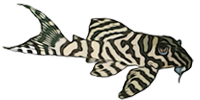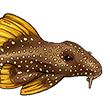Breeding upside downers
-
grouchybroad
- Posts: 3
- Joined: 29 Oct 2007, 05:50
- Location 1: hone
- Interests: Fish galore especially cat and angels
Breeding upside downers
Has anyone had any luck getting your colony of these beauties to lay eggs? I have five frisky cats and would really like to try to get some fry but haven't a clue how to get started.
Life is a circus parade, so enjoy the ride!!!
- Richard B
- Posts: 6952
- Joined: 11 Aug 2006, 13:19
- I've donated: $20.00!
- My articles: 9
- My images: 11
- My cats species list: 37 (i:0, k:0)
- My aquaria list: 4 (i:0)
- My BLogs: 2 (i:0, p:29)
- Spotted: 10
- Location 1: on the sofa, or maybe at work?
- Location 2: Warwickshire: UK
- Interests: Tanganyika Catfish, African catfish, Non-loricariid sucker-catfish.
Running, drinking, eating, sci-fi, stapelids
Welcome to Planet catfish 
I an presuming you are referring to Synodontis Nigriventris as the common , true upside down catfish.
There are sporadic reports of these spawning in captivity in literature bit these are sparse & mostly accidental. You can see information on this if you look at the species information in the cat-e-log section.
Needless to say the first priority is to ensure you have a mixed sex group - in such small species genital papillae may not be as obvious as in other species, but other differences are in the plumper bodies of females, particularly when they have not just had a good feed. Leaf litter may be a good idea but they'll need good water conditions & varied top quality diet to bring them into condition. A significant temperature drop created by addition of cool water to simulate the start of a rainy season is advised as a trigger.
Probably the best piece of advice i can give would be to keep trying!
I an presuming you are referring to Synodontis Nigriventris as the common , true upside down catfish.
There are sporadic reports of these spawning in captivity in literature bit these are sparse & mostly accidental. You can see information on this if you look at the species information in the cat-e-log section.
Needless to say the first priority is to ensure you have a mixed sex group - in such small species genital papillae may not be as obvious as in other species, but other differences are in the plumper bodies of females, particularly when they have not just had a good feed. Leaf litter may be a good idea but they'll need good water conditions & varied top quality diet to bring them into condition. A significant temperature drop created by addition of cool water to simulate the start of a rainy season is advised as a trigger.
Probably the best piece of advice i can give would be to keep trying!
-
grouchybroad
- Posts: 3
- Joined: 29 Oct 2007, 05:50
- Location 1: hone
- Interests: Fish galore especially cat and angels
breeding upside down cats
Thank you for the information. I have never heard of adding leaf litter. Just what constitutes "leaf litter"? I live in MO and our common trees are all hardwoods ie 15 varieties of oak. Also does this make a difference when trying to breed cories?
Life is a circus parade, so enjoy the ride!!!
- MatsP
- Posts: 21038
- Joined: 06 Oct 2004, 13:58
- My articles: 4
- My images: 28
- My cats species list: 117 (i:33, k:0)
- My aquaria list: 10 (i:8)
- My BLogs: 4 (i:0, p:164)
- Spotted: 187
- Location 1: North of Cambridge
- Location 2: England.
Leaf litter is just leaves of trees that you soak for a while [so that they sink]. Oak leaves are on the list of "good leaves", so that would be great. I expect that "Live Oak" that is common in the southern US is an ideal candidate - those leaves I expect to last for a very long time in the water.
--
Mats
--
Mats
-
grouchybroad
- Posts: 3
- Joined: 29 Oct 2007, 05:50
- Location 1: hone
- Interests: Fish galore especially cat and angels
Forgive me. I was doing the "stupid American" thing again. I did not notice you were responding from the UK. Live oak trees are a truly southern US tree type, particularly of Georgia and Florida. I live a full 850 miles (or 1368 kilometers) north and west of any such tree although a item search states that some said trees can grow about 300 miles south of my state in theory. Here in northern Missouri (MO), we have too much snow and too little swampy ground to keep alive that cool moss stuff hanging from those oak trees (hense "live oak"). (I had ice in a bucket left out Tues night) The oak trees around here are the kind that "red oak" furniture are made. Sorry again. I really appreciate your suggestions about the upside down catfish. I'll try some red oak leaves and let you know.
Life is a circus parade, so enjoy the ride!!!




